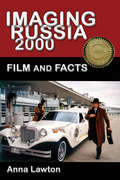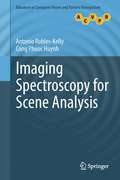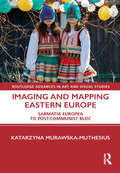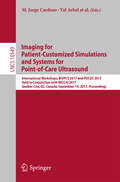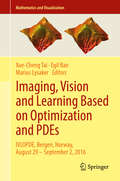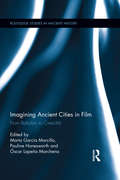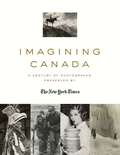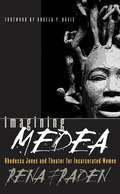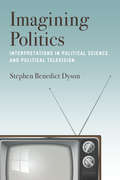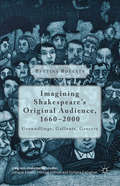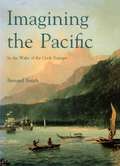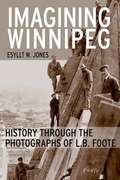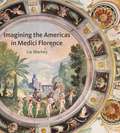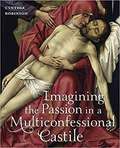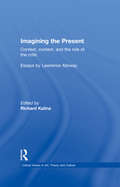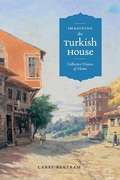- Table View
- List View
Imaging Russia 2000: Film and Facts
by Anna Lawton“[A] sparkling and original work . . . I can think of no better guide to the heart of post-Soviet urban Russia than this entertaining and refreshing book.” —Richard Stites, Professor of History, Georgetown UniversityThis book incorporates into an organic whole the realities of the 1990s in Russia, focusing on film production, the films themselves, and the socio-political-cultural context. It aims to provide a picture of Russia (with Moscow in the foreground) as the big stage on which the drama unfolded. The author discusses some eighty films made between 1990 and 2000. Many reflect the reality of the present day, either in dramatic or grotesque form. Others reassess the past, placing different spins on various epochs and figures according to the director’s ideological orientation. Still others offer escapism into imaginary worlds. The films selected may vary in technical quality and depth of thought; they may be mainstream pictures, or art films. But taken together, they provide an eloquent portrait of Russia, entering the new millennium still in search of its true identity.A Choice Outstanding Academic Title“Anna Lawton deftly tells two stories—one about the evolution of Russian film since the collapse of the Soviet Union in 1991, and the other about Russian life during that same period. She managed to capture a vivid portrait of Moscow of the 1990s, and to remind us that the Soviet past remains omnipresent in the new Russia . . . a must read for anyone who cares about Russia, or about film.” —Blair Ruble, Director, The Kennan Institute of the Woodrow Wilson Center
Imaging Spectroscopy for Scene Analysis
by Cong Phuoc Huynh Antonio Robles-KellyThis book presents a detailed analysis of spectral imaging, describing how it can be used for the purposes of material identification, object recognition and scene understanding. The opportunities and challenges of combining spatial and spectral information are explored in depth, as are a wide range of applications. Features: discusses spectral image acquisition by hyperspectral cameras, and the process of spectral image formation; examines models of surface reflectance, the recovery of photometric invariants, and the estimation of the illuminant power spectrum from spectral imagery; describes spectrum representations for the interpolation of reflectance and radiance values, and the classification of spectra; reviews the use of imaging spectroscopy for material identification; explores the recovery of reflection geometry from image reflectance; investigates spectro-polarimetric imagery, and the recovery of object shape and material properties using polarimetric images captured from a single view.
Imaging and Mapping Eastern Europe: Sarmatia Europea to Post-Communist Bloc (Routledge Advances in Art and Visual Studies)
by Katarzyna Murawska-MuthesiusImaging and Mapping Eastern Europe puts images centre stage and argues for the agency of the visual in the construction of Europe’s east as a socio-political and cultural entity. This book probes into the discontinuous processes of mapping the eastern European space and imaging the eastern European body. Beginning from the Renaissance maps of Sarmatia Europea, it moves onto the images of women in ethnic dress on the pages of travellers’ reports from the Balkans, to cartoons of children bullied by dictators in the satirical press, to Cold War cartography, and it ends with photos of protesting crowds on contemporary dust jackets. Studying the eastern European ‘iconosphere’ leads to the engagement with issues central for image studies and visual culture: word and image relationship, overlaps between the codes of othering and self-fashioning, as well as interaction between the diverse modes of production specific to cartography, travel illustrations, caricature, and book cover design. This book will be of interest to scholars in art history, visual culture, and central Asian, Russian and Eastern European studies.
Imaging for Patient-Customized Simulations and Systems for Point-of-Care Ultrasound: International Workshops, BIVPCS 2017 and POCUS 2017, Held in Conjunction with MICCAI 2017, Québec City, QC, Canada, September 14, 2017, Proceedings (Lecture Notes in Computer Science #10549)
by M. Jorge Cardoso, Tal Arbel, João Manuel R.S. Tavares, Stephen Aylward, Shuo Li, Emad Boctor, Gabor Fichtinger, Kevin Cleary, Bradley Freeman, Luv Kohli, Deborah Shipley Kane, Matt Oetgen and Sonja PujolThis book constitutes the refereed joint proceedings of the International Workshop on Bio-Imaging and Visualization for Patient-Customized Simulations, BIVPCS 2017, and the International Workshop on Point-of-Care Ultrasound, POCUS 2017, held in conjunction with the 20th International Conference on Medical Imaging and Computer-Assisted Intervention, MICCAI 2017, in Québec City, QC, Canada, in September 2017. The 12 full papers presented at BIVPCS 2017 and the 7 full papers presented at POCUS 2017 were carefully reviewed and selected. The papers feature research from complementary fields such as signal and image processing, mechanics, computational vision, mathematics, physics, informatics, computer graphics, bio-medical-practice, psychology and industry as well as ultrasound image systems applications.
Imaging in Advertising: Verbal and Visual Codes of Commerce
by Fern L. JohnsonThe dominance of advertising in everyday life carries potent cultural meaning. As a major force in the rise of "image based culture," advertising spreads images that shape how people live their lives. While scholarship on visual images has advanced our understanding of the role of advertising in society, for example in revealing how images of extremely thin female models and athletic heroes shape ideals and aspirations, images circulated through lagnuage codes--or "verbal images"--in advertising have received less attention. Imaging in Advertising explores how the verbal and visual work together to build a discourse of advertising that speaks to audiences and has the power to move them to particular thoughts and actions. In this book, Fern L. Johnson presents a series of case studies exploring important advertising images--racial connotations in cigarette advertising, representations of cultural diversity in teen television commercials, metaphors of the face appearing in ads for skin care products, language borrowed from technology to sell non-technology products, and the illusion of personal choice that is promoted in many Internet web sites. Johnson argues that examining the interplay of verbal and visual images as a structured whole exposes the invase role of advertising in shaping culture in 21st century America.
Imaging the Cheops Pyramid
by H. D. BuiIn this book Egyptian Archeology and Mathematics meet. The author is an expert in theories and applications in Solid Mechanics and Inverse Problems, a former professor at Ecole Polytechnique and now works with Electricité de France on maintenance operations on nuclear power plants. In the Autumn of 1986, after the end of the operation on the King's chamber conducted under the Technological and Scientific Sponsorship of EDF, to locate a cavity, he was called to solve a mathematical inverse problem, to find the unknown tomb of the King and the density structure of the whole pyramid based on measurements of microgravity made inside and outside of the pyramid. This book recounts the various search operations on the pyramid of Cheops made at the request of the Egyptian and French authorities in 1986-1987. After the premature end of the Cheops operation in the Autumn of 1986, following the fiasco of unsuccessful drillings in the area suspected by both architects G. Dormion and J.P. Goidin and microgravity auscultation, EDF and CPGF (a geophysical company) teams continued their researches with measurements already made, trying this time an inversion of the Newton gravity equation for the entire pyramid and using another theoretical team led by the author. The inverse problem solution confirmed the results of auscultations, but found no cavity. However, the image of the average density at the surface of the entire pyramid forms a sort of square "spiral" probably related to the construction method. In 2000, Jean-Pierre Houdin considered the author's results of 1988 as a confirmation of his theory of the internal ramp tunnel. Since then the author has done additional research and found that classical theories of the construction based on degrees and the particular mode of stones filling can also report the same densitogram. The book is richly illustrated with color figures. It is dotted with information concerning Physics, Mechanics and the History of Egyptian Antiquities. The book ends with the greatest mystery of the pyramid about the unknown tomb of the King and a dream to see the tomb at an unexpected place.
Imaging, Vision and Learning Based on Optimization and PDEs: IVLOPDE, Bergen, Norway, August 29 – September 2, 2016 (Mathematics and Visualization)
by Xue-Cheng Tai Egil Bae Marius LysakerThis volume presents the peer-reviewed proceedings of the international conference Imaging, Vision and Learning Based on Optimization and PDEs (IVLOPDE), held in Bergen, Norway, in August/September 2016. The contributions cover state-of-the-art research on mathematical techniques for image processing, computer vision and machine learning based on optimization and partial differential equations (PDEs). It has become an established paradigm to formulate problems within image processing and computer vision as PDEs, variational problems or finite dimensional optimization problems. This compact yet expressive framework makes it possible to incorporate a range of desired properties of the solutions and to design algorithms based on well-founded mathematical theory. A growing body of research has also approached more general problems within data analysis and machine learning from the same perspective, and demonstrated the advantages over earlier, more established algorithms. This volume will appeal to all mathematicians and computer scientists interested in novel techniques and analytical results for optimization, variational models and PDEs, together with experimental results on applications ranging from early image formation to high-level image and data analysis.
Imagining Ancient Cities in Film: From Babylon to Cinecittà (Routledge Studies in Ancient History)
by Marta Garcia Morcillo Pauline Hanesworth Óscar Lapeña MarchenaIn film imagery, urban spaces show up not only as spatial settings of a story, but also as projected ideas and forms that aim to recreate and capture the spirit of cultures, societies and epochs. Some cinematic cities have even managed to transcend fiction to become part of modern collective memory. Can we imagine a futuristic city not inspired at least remotely by Fritz Lang’s Metropolis? In the same way, ancient Babylon, Troy and Rome can hardly be shaped in popular imagination without conscious or subconscious references to the striking visions of Griffiths’ Intolerance, Petersen’s Troy and Scott’s Gladiator, to mention only a few influential examples. Imagining Ancient Cities in Film explores for the first time in scholarship film representations of cities of the Ancient World from early cinema to the 21st century. The volume analyzes the different choices made by filmmakers, art designers and screen writers to recreate ancient urban spaces as more or less convincing settings of mythical and historical events. In looking behind and beyond intended archaeological accuracy, symbolic fantasy, primitivism, exoticism and Hollywood-esque monumentality, this volume pays particular attention to the depiction of cities as faces of ancient civilizations, but also as containers of moral ideas and cultural fashions deeply rooted in the contemporary zeitgeist and in continuously revisited traditions.
Imagining Apocalyptic Politics in the Anthropocene (Routledge Environmental Humanities)
by Earl T. HarperBringing together scholars from English literature, geography, politics, the arts, environmental humanities and sociology, Imagining Apocalyptic Politics in the Anthropocene contributes to the emerging debate between bodies of thought first incepted by scholars such as Mouffe, Whyte, Kaplan, Hunt, Swyngedouw and Malm about how apocalyptic events, narratives and imaginaries interact with societal and individual agency historically and in the current political moment. Exploring their own empirical and philosophical contexts, the authors examine the forms of political acting found in apocalyptic imaginaries and reflect on what this means for contemporary society. By framing their arguments around either pre-apocalyptic, peri-apocalyptic or post-apocalyptic narratives and events, a timeline emerges throughout the volume which shows the different opportunities for political agency the anthropocenic subject can enact at the various stages of apocalyptic moments. Featuring a number of creative interventions exclusively produced for the work from artists and fiction writers who engage with the themes of apocalypse, decline, catastrophe and disaster, this innovative book will be of great interest to students and scholars of the politics of climate change, the environmental humanities, literary criticism and eco-criticism.
Imagining Bodies and Performer Training: The Legacies of Jacques Lecoq and Gaston Bachelard (Perspectives on Performer Training)
by Ellie NixonThis book is a practical and theoretical exploration of the embodied imagining processes of devised performance in which the human and more-than-human are co-implicated in the creative process.This study brings together the work of French theatre pedagogue Jacques Lecoq (1921–1999) and French philosopher of science and the imagination Gaston Bachelard (1884–1962) to explore the notion of the imagination as embodied, enactive and embedded in the devising process. An exploration of compelling correspondences with Bachelard, whose writings imbue Lecoq’s teaching ethos, offers new practical and theoretical perspectives on Lecoq’s ‘poetic body’ in contemporary devising practices. Interweaving first-hand accounts by the author and interviews with contemporary international creative practitioners who have graduated from or have been deeply influenced by Lecoq, Imagining Bodies in Performer Training interrogates how his teachings have been adapted, developed and extended in various cultural, political and historical settings, in Europe, Scandinavia, Asia, and North and South America.These new and rich insights reveal a teaching approach that resists fixity and instead unfolds, develops and adapts to the diverse cultural and political contexts of its practitioners, teachers and students.
Imagining Canada: A Century of Photographs Preserved By The New York Times
by William MorassuttiSophisticated and well-curated, this photographic tour through Canada's history documents the nation's evolution over more than a century, as seen through the lens of photographers from The New York Times. The book compiles more than 100 iconic, momentous and inspiring images of Canada and includes ten commentary pieces from a range of important thinkers, historians and writers, including National Chief Shawn Atleo, MP Justin Trudeau, historians Charlotte Gray, Peter C. Newman and Tim Cook, and sports columnist Stephen Brunt. Through these pages and images, which represent a portal in time, a portrait of Canada emerges, not as seen by its own citizens, but as viewed through a distinctly American lens.The book includes photos arranged according to the following themes: • The Battlefield: Canada at War • Aboriginal People • The Changing Face of Canadian Society--Our Immigration Story • Landscape • The Political Arena • Industry • The War Machine: How the Homefront Supplied the Wars • Hockey • Icons (Stars, Sports Heroes, Political Figures, Royalty)
Imagining Human Rights in Twenty-First-Century Theater
by Brenda Werth Florian N. Becker Paola S. Hern�ndezThere is extraordinary diversity, depth, and complexity in the encounter between theatre, performance, and human rights. Through an examination of a rich repertoire of plays and performance practices from and about countries across six continents, the contributors open the way toward understanding the character and significance of this encounter.
Imagining Imaging
by Michael R. JacksonFrom Roentgen to Rembrandt, Hounsfield to Hollywood and Vesalius to videogames, Imagining Imaging explores the deeply entwined relationship between art (and visual-based culture) and radiology / medical imaging. Including artworks from numerous historical eras representing varied geographic locations and visual traditions, alongside a diverse range of contemporary artists, Dr Jackson argues that the foundations of medical image construction and interpretation were laid down in artistic innovations dating back hundreds and thousands of years. Since the discovery of X-rays, artists and moviemakers have, in turn, drawn rich inspiration from radiographic imagery and concepts, but the process of cross-pollination between art and science has continued, with creative endeavour continuing to mould medical imaging examinations to this day.Blending a unique mix of art, science and medical history, together with aspects of visual neurophysiology and psychology, Imagining Imaging is essential reading for radiologists, radiographers and artists alike. Peppered with familiar TV and film references, personal insights into the business of image interpretation, and delivered in an accessible and humorous style, the book will also appeal to anyone who enjoys looking at pictures.Key features: Engaging synthesis of art and medical history, combined with anecdotes and experiences from a working clinical radiologist Diverse range of visual reference points including astronomy, botany and cartography, alongside comprehensive discussion of medical imaging modalities including plain radiography, ultrasound, CT and MRI 200 full colour illustrations
Imagining Medea
by Rena FradenThis ain't no Dreamgirls," Rhodessa Jones warns participants in the Medea Project, the theater program for incarcerated women that she founded and directs. Her expectations are grounded in reality, tempered, for example, by the fact that women are the fastest growing population in U.S. prisons. Still, Jones believes that by engaging incarcerated women in the process of developing and staging dramatic works based on their own stories, she can push them toward tapping into their own creativity, confronting the problems that landed them in prison, and taking control of their lives. Rena Fraden chronicles the collaborative process of transforming incarcerated women's stories into productions that incorporate Greek mythology, hip-hop music, dance, and autobiography. She captures a diverse array of voices, including those of Jones and other artists, the sheriff and prison guards, and, most vividly, the women themselves. Through compelling narrative and thoughtful commentary, Fraden investigates the Medea Project's blend of art and activism and considers its limits and possibilities for enacting social change.Rhodessa Jones is co-artistic director of the San Francisco-based performance company Cultural Odyssey and founder of the Medea Project: Theater for Incarcerated Women. An award-winning performer, she has taught at the Yale School of Drama and the New College of California.
Imagining Politics: Interpretations in Political Science and Political Television
by Stephen Benedict DysonImagining Politics critically examines two interpretations of government. The first comes from pop culture fictions about politics, the second from academic political science. Stephen Benedict Dyson argues that televised political fictions and political science theories are attempts at meaning-making, reflecting and shaping how a society thinks about its politics. By taking fiction seriously, and by arguing that political science theory is homologous to fiction, the book offers a fresh perspective on both, using fictions such as The West Wing, House of Cards, Borgen, Black Mirror, and Scandal to challenge the assumptions that construct the discipline of political science itself. Imagining Politics is also about a political moment in the West. Two great political shocks—Brexit and the election of Donald Trump—are set in a new context here. Dyson traces how Brexit and Trump campaigned against our image of politics as usual, and won.
Imagining Shakespeare's Original Audience, 1660-2000: Groundlings, Gallants, Grocers (Palgrave Shakespeare Studies)
by Bettina BoeckerComparatively little is known about Shakespeare's first audiences. This study argues that the Elizabethan audience is an essential part of Shakespeare as a site of cultural meaning, and that the way criticism thinks of early modern theatregoers is directly related to the way it thinks of, and uses, the Bard himself.
Imagining The Pacific
by Bernard SmithIn this book Bernard Smith explores in more depth the issued first dealt with in his classic European Vision and the South Pacific. He continues his careful examination of how European artists and scientists travelling to the Pacific during the time of Cook's voyages were stimulated to see the world in new and creative ways. In analysing intensely personal responses to a new accessible environment, Bernard Smith shows how science, topography and travel had an impact on current pictorial genres. Among many surprising findings he argues that the obligation science placed on art to provide information was a factor in the triumph of Impressionism during the late nineteenth century. With its breadth of vision and attention to detail, its exploration of the complex relationship between the pursuit of knowledge and the exercise of power, Imagining the Pacific takes its place alongside Bernard Smith's earlier work as a milestone in historical scholarship.
Imagining Winnipeg: History through the Photographs of L.B. Foote
by Esyllt W. JonesIn an expanding and socially fractious early twentieth-century Winnipeg, Lewis Benjamin Foote (1873-1957) rose to become the city’s pre-eminent commercial photographer. Documenting everything from royal visits to deep poverty, from the building of the landmark Fort Garry Hotel to the turmoil of the 1919 General Strike, Foote’s photographs have come to be iconic representations of early Winnipeg life. They have been used to illustrate everything from academic histories to posters for rock concerts; they have influenced the work of visual artists, writers, and musicians; and they have represented Winnipeg to the nation. But in Imagining Winnipeg, historian Esyllt W. Jones takes us beyond the iconic to reveal the complex artist behind the lens and the conflicting ways in which his photographs have been used to give credence to diverse and sometimes irreconcilable views of Winnipeg’s past. Incorporating 150 stunning photographs from the more than 2,000 images in the Archives of Manitoba Foote Collection, Imagining Winnipeg challenges our understanding of visual history and the city we thought we knew.
Imagining the Americas in Medici Florence
by Lia MarkeyThe first full-length study of the impact of the discovery of the Americas on Italian Renaissance art and culture, Imagining the Americas in Medici Florence demonstrates that the Medici grand dukes of Florence were not only great patrons of artists but also early conservators of American culture.In collecting New World objects such as featherwork, codices, turquoise, and live plants and animals, the Medici grand dukes undertook a “vicarious conquest” of the Americas. As a result of their efforts, Renaissance Florence boasted one of the largest collections of objects from the New World as well as representations of the Americas in a variety of media. Through a close examination of archival sources, including inventories and Medici letters, Lia Markey uncovers the provenance, history, and meaning of goods from and images of the Americas in Medici collections, and she shows how these novelties were incorporated into the culture of the Florentine court. More than just a study of the discoveries themselves, this volume is a vivid exploration of the New World as it existed in the minds of the Medici and their contemporaries. Scholars of Italian and American art history will especially welcome and benefit from Markey’s insight.
Imagining the Americas in Medici Florence
by Lia MarkeyThe first full-length study of the impact of the discovery of the Americas on Italian Renaissance art and culture, Imagining the Americas in Medici Florence demonstrates that the Medici grand dukes of Florence were not only great patrons of artists but also early conservators of American culture.In collecting New World objects such as featherwork, codices, turquoise, and live plants and animals, the Medici grand dukes undertook a “vicarious conquest” of the Americas. As a result of their efforts, Renaissance Florence boasted one of the largest collections of objects from the New World as well as representations of the Americas in a variety of media. Through a close examination of archival sources, including inventories and Medici letters, Lia Markey uncovers the provenance, history, and meaning of goods from and images of the Americas in Medici collections, and she shows how these novelties were incorporated into the culture of the Florentine court. More than just a study of the discoveries themselves, this volume is a vivid exploration of the New World as it existed in the minds of the Medici and their contemporaries. Scholars of Italian and American art history will especially welcome and benefit from Markey’s insight.
Imagining the Audience in Early Modern Drama, 1558–1642
by Jennifer A. Low Nova MyhillThis essay collection builds on the latest research on the topic of theatre audiences in early modern England. In broad terms, the project answers the question, 'How do we define the relationships between performance and audience?'.
Imagining the Byzantine Past
by Elena N. BoeckTwo lavish, illustrated histories confronted and contested the Byzantine model of empire. The Madrid Skylitzes was created at the court of Roger II of Sicily in the mid-twelfth century. The Vatican Manasses was produced for Ivan Alexander of Bulgaria in the mid-fourteenth century. Through close analysis of how each chronicle was methodically manipulated, this study argues that Byzantine history was selectively re-imagined to suit the interests of outsiders. The Madrid Skylitzes foregrounds regicides, rebellions, and palace intrigue in order to subvert the divinely ordained image of order that Byzantine rulers preferred to project. The Vatican Manasses presents Byzantium as a platform for the accession of Ivan Alexander to the throne of the Third Rome, the last and final world-empire. Imagining the Byzantine Past demonstrates how distinct visions of empire generated diverging versions of Byzantium's past in the aftermath of the Crusades.
Imagining the Passion in a Multiconfessional Castile
by Cynthia RobinsonRecent research into the texts, practices, and visual culture of late medieval devotional life in western Europe has clearly demonstrated the centrality of devotions to Christ’s Passion. The situation in Castile, however, could not have been more different. Prior to the final decades of the fifteenth century, individual relationships to Christ established through the use of “personalized” Passion imagery simply do not appear to have been a component of Castilian devotional culture.
Imagining the Present: Context, Content, and the Role of the Critic (Critical Voices in Art, Theory and Culture)
by Lawrence AllowayBringing together twenty-nine of Lawrence Alloway’s most influential essays in one volume, this fascinating collection provides valuable perspectives on the art and visual culture of the second half of the twentieth century. Lawrence Alloway ranks among the most important critics of his time, and his contributions to the spirited and contentious dialogue of his era make for fascinating reading. These twenty-nine provocative essays from 1956 to 1980 from the man who invented the term ‘pop art’ bring art, film, iconography, cybernetics and culture together for analysis and investigation, and do indeed examine the context, content and role of the critic in art and visual culture. Featuring a critical commentary by Richard Kalina, and preface by series editor Saul Ostrow, Imagining the Present will be an enthralling read for all art and visual culture students.
Imagining the Turkish House: Collective Visions of Home
by Carel Bertram"Houses can become poetic expressions of longing for a lost past, voices of a lived present, and dreams of an ideal future." <P><P>Carel Bertram discovered this truth when she went to Turkey in the 1990s and began asking people about their memories of "the Turkish house." The fondness and nostalgia with which people recalled the distinctive wooden houses that were once ubiquitous throughout the Ottoman Empire made her realize that "the Turkish house" carries rich symbolic meaning. In this delightfully readable book, Bertram considers representations of the Turkish house in literature, art, and architecture to understand why the idea of the house has become such a potent signifier of Turkish identity.
